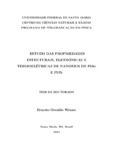| dc.creator | Wrasse, Ernesto Osvaldo | |
| dc.date.accessioned | 2017-05-05 | |
| dc.date.available | 2017-05-05 | |
| dc.date.issued | 2013-04-29 | |
| dc.identifier.citation | WRASSE, Ernesto Osvaldo. Study of the structural, electronic and thermoelectric properties of PbSe and PbTe nanowires. 2013. 204 f. Tese (Doutorado em Física) - Universidade Federal de Santa Maria, Santa Maria, 2013. | por |
| dc.identifier.uri | http://repositorio.ufsm.br/handle/1/3912 | |
| dc.description.abstract | In this work we study simultaneously the structural, electronic and thermoelectric
properties of PbSe and PbTe nanowires, analyzing the quantum confinement effects, the
dependence with the planar stoichiometry and the spin-orbit interactions. We also study
these nanowires in the presence of intrinsic defects (vacancies and antisites) and doped
with group III (Al, Ga, In, and Tl) impurity. We use first principles calculations within
the formalism of the density functional theory (DFT). We observed that the nanowires are
more stable in the rock salt structure and aligned along the (001) direction. The electronic
properties of nanowires are in
uenced by three effects: the quantum confinement, spinorbit
interactions and the planar stoichiometry. The quantum confinement increases the
thermoelectric efficiency of the PbSe and PbTe nanowires when compared to the system in
the bulk phase, reaching an increase up to two orders in the magnitude, leading the PbSe
and PbTe nanowires with great potential to be used in thermoelectric devices. We studied
the in
uence of intrinsic defects and group III impurity doping in the main properties of
PbSe and PbTe, we show that these defects give rise to different electronic properties in the
nanowires as compared to the bulk one. Intrinsic defects and group III impurities, which
modify the electronic density of states (DOS) near to the top of the valence band or near to
the bottom of the conduction band increase the thermoelectric efficiency of the PbSe and PbTe nanowires. However, defects that introduce electronic levels in energy band gap are
shown to cause and degradation in the thermoelectric efficiency. The increase (decrease)
in thermoelectric efficiency is associated with a lower (higher) value of electronic part of
the thermal conductivity. In summary, we show that PbSe and PbTe nanowires are very
promising materials to be used in thermoelectric, electronic and optical devices. | eng |
| dc.description.sponsorship | Coordenação de Aperfeiçoamento de Pessoal de Nível Superior | |
| dc.format | application/pdf | por |
| dc.language | por | por |
| dc.publisher | Universidade Federal de Santa Maria | por |
| dc.rights | Acesso Aberto | por |
| dc.subject | Teoria do funcional da densidade | por |
| dc.subject | Nanofios | por |
| dc.subject | Defeitos | por |
| dc.subject | Impurezas | por |
| dc.subject | Termoeletricidade | por |
| dc.subject | Density functional theory | eng |
| dc.subject | Nanowires | eng |
| dc.subject | Defects | eng |
| dc.subject | Impurities | eng |
| dc.subject | Thermoelectricity | eng |
| dc.title | Estudo das propriedades estruturais, eletrônicas e termoelétricas de nanofios de PbSe e PbTe | por |
| dc.title.alternative | Study of the structural, electronic and
thermoelectric properties of PbSe and PbTe
nanowires | eng |
| dc.type | Tese | por |
| dc.description.resumo | Neste trabalho estudamos simultaneamente as propriedades estruturais, eletrônicas e termoelétricas de nanofios de PbSe e PbTe, analisando os efeitos do confinamento quântico,
a dependência com a estequiometria planar e a interação spin-órbita. Estudamos também estes nanofios na presença de defeitos intrínsecos (vacâncias e antissítios) e impurezas do
grupo III (Al, Ga, In e Tl). Utilizamos cálculos de primeiros pincípios dentro do formalismo da teoria do funcional da densidade (DFT). Observamos que os nanofios são mais estáveis na estrutura rock salt, e alinhados ao longo da direção (001). As propriedades eletrônicas desse nanofios são influenciadas por
três efeitos: o confinamento quântico, a interação spin-órbita, e a estequiometria planar. O confinamento quântico aumenta a eficiência termoelétrica do PbSe e PbTe em comparação ao observado para o bulk, chegando a um aumento de até duas ordens de grandeza, fazendo com que os nanofios de PbSe e PbTe tenham um grande potencial para serem utilizados em dispositivos termoelétricos. Estudamos a influência de defeitos intrínsecos e da dopagem de impurezas do grupo III nas principais propriedades do PbSe e PbTe, onde mostramos que essa influência é diferente no bulk e no nanofio. Defeitos intrínsecos e impurezas do grupo III que alteram a densidade de estados eletrônicos (DOS) nas proximidades do topo da banda de valência ou do fundo da banda de condução, observamos um aumento da ficiência termoelétrica dos nanofios de PbSe e PbTe. Porém aqueles que introduzem níveis no gap de energia fazem com que a eficiencia termoelétrica diminua. O aumento (diminuição) da eficiência termoelétrica está associado(a) ao menor (maior) valor da comdutividade térmica eletrônica. De maneira geral, mostramos que nanofios de PbSe e PbTe são materiais muito promissores para a aplicação em dispositivos termoelétricos, eletrônicos, óticos, etc. | por |
| dc.contributor.advisor1 | Baierle, Rogério José | |
| dc.contributor.advisor1Lattes | http://lattes.cnpq.br/7565203547830128 | por |
| dc.contributor.referee1 | Costa Junior, Antonio Tavares da | |
| dc.contributor.referee1Lattes | http://lattes.cnpq.br/5990729462575602 | por |
| dc.contributor.referee2 | Sommer, Rubem Luis | |
| dc.contributor.referee2Lattes | http://lattes.cnpq.br/7705036710106784 | por |
| dc.contributor.referee3 | Muñoz, Walter Manuel Orellana | |
| dc.contributor.referee3Lattes | http://lattes.cnpq.br/7956122617080530 | por |
| dc.contributor.referee4 | Zimmer, Fábio Mallmann | |
| dc.contributor.referee4Lattes | http://lattes.cnpq.br/6328420212181284 | por |
| dc.creator.Lattes | http://lattes.cnpq.br/8403511647803361 | por |
| dc.publisher.country | BR | por |
| dc.publisher.department | Física | por |
| dc.publisher.initials | UFSM | por |
| dc.publisher.program | Programa de Pós-Graduação em Física | por |
| dc.subject.cnpq | CNPQ::CIENCIAS EXATAS E DA TERRA::FISICA | por |


